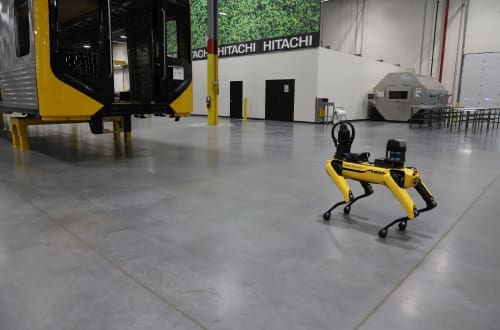- Services
Technology Capabilities
Technology Capabilities- Product Strategy & Experience DesignDefine software-driven value chains, create purposeful interactions, and develop new segments and offerings.
- Digital Business TransformationAdvance your digital transformation journey.
- Intelligence EngineeringLeverage data and AI to transform products, operations, and outcomes.
- Software Product EngineeringCreate high-value products faster with AI-powered and human-driven engineering.
- Technology ModernizationTackle technology modernization with approaches that reduce risk and maximize impact.
- Embedded Engineering & IT/OT TransformationDevelop embedded software and hardware. Build IoT and IT/OT solutions.
- Industries
- GlobalLogic VelocityAI
- Insights
BlogsDecember 16, 2024Gene LeybzonAccelerating Digital Transformation with Structured AI Outputs
This code produces the following output that can be imported into the candidate trackin...
 BlogsOctober 30, 2024Yuriy Yuzifovich
BlogsOctober 30, 2024Yuriy YuzifovichAccelerating Enterprise Value with AI
Discover how financial services integrations are transforming from standalone offerings...

- About Us
Press ReleaseGlobalLogicSeptember 23, 2025Hitachi agrees to acquire German data and AI services firm ...
Strengthening GlobalLogic’s data and consulting capabilities and expanding footprint in...
 Press ReleaseGlobalLogicSeptember 10, 2025
Press ReleaseGlobalLogicSeptember 10, 2025GlobalLogic and Ericsson Deploy Private 5G Network at Hitachi ...
The new infrastructure is the digital backbone of the Hagerstown plant, enhancing effic...

- Careers
Published on February 23, 2023Tips for Staying Relevant in the Age of Creative AIs Like ChatGPT
View all articles Dr. Jim WalshCTOShareRelated Content
Dr. Jim WalshCTOShareRelated Content GlobalLogic3 December 2025
GlobalLogic3 December 2025 GlobalLogic1 December 2025View All Insights
GlobalLogic1 December 2025View All Insights GlobalLogic27 November 2025Recommended authorsDirector, Industrial BU GSPSenior Vice President & Head of EMEAView all authorsVice President & Consumer Business, Americas GlobalLogic
GlobalLogic27 November 2025Recommended authorsDirector, Industrial BU GSPSenior Vice President & Head of EMEAView all authorsVice President & Consumer Business, Americas GlobalLogicLet's start engineering impact together
GlobalLogic provides unique experience and expertise at the intersection of data, design, and engineering.
Get in touchAI GovernanceMLOpsCross-IndustryWhat I would call “creative AIs” are causing a lot of concern about the future of the human role in creative activities, including but far from limited to software development. These creative AIs include ChatGPT and similar systems in the pipeline from Microsoft, Google and certainly many others. I’ve gotten questions about the impact on people’s lives and careers from software engineers, college students, and various creative professionals I know, including those in my own family.Like it or not, we live in a time of change, where a critical mass of technology innovation is having a dramatic impact on the way we live and work. With increasingly ‘intelligent’ systems, these innovations have reached a point where people are beginning to question what makes them human and valuable. In particular, given the advent of creative AIs, many have started to wonder what value a human can bring to the table that cannot be done at least as well by a machine?
Fortunately for us, this situation is not unique to our generation; it’s been repeated throughout human history. We can learn about what’s likely to happen to us by thinking about those earlier revolutions.
One that comes to mind is the Industrial Revolution of the late 1700’s through the early 1800’s. During this period, the production of textiles in particular moved from an activity done largely by hand, at home, to work done by machines in a factory. This shift of work from humans to machines had a profound impact on:
- the family and the way people lived (moving work from relatively isolated homes and families to centralized factories and employees),
- population distribution and urban planning,
- the environment,
- the economic and ‘class’ structure of society,
- the creation of wealth and sometimes institutionalization of poverty,
- the structure of trade, politics, international relations, and every aspect of society.
This was all driven by a revolutionary set of then-new technologies.
But rest assured I don’t plan to give a history lesson, though this is a fascinating subject. I think what’s more interesting and relevant to our current situation is to think about which skill sets would have remained relevant during this time of profound technological change. We often get more perspective looking back at something that already happened than forward into an unknown future. Let’s try that for a moment and see what lessons we might bring back to our own times.
Recommended reading: AI’s Impact on Software Development: Where We Are & What Comes Next
Imagine that you are a weaver working from home and making money from weaving highly in-demand everyday cloth on a hand-powered loom. Because you naturally want to create a fabric that’s in demand, you might make a fabric like (anachronistically) the now-popular “denim jeans fabric” of our own day, or the muslin fabric popular in the early 1800’s.
Even if you’re good at it, does your job survive the industrialization of textile manufacturing?
I would argue that if the work you did has a broad enough market that a factory can be profitable manufacturing it, and if your work can be successfully replicated by machine, then you would lose that work as a livelihood. You could not compete with the ability of the factory to develop essentially the same product at much higher volumes and lower cost. In most cases, your best option would be to leverage your current skills to become a machine operator in a factory — which many weavers in fact actually did.
Surviving a Technological Revolution as a Producer
If you were a skilled hand-weaver, some exceptions to this loss of career might be available to you, if:
You created “niche” fabrics.
Your niche would need to appeal to a very specific market segment that was affluent enough to buy your product, but not so large as to be attractive to a manufacturer’s need to find economies of scale, or to attract serious attention from inventors of new technologies.
The quality of your output was so much greater than could be produced by machine that there was a continued demand for your cloth.
There will always be some things machines can’t yet do well, and that humans can currently do better—for example in the manufactured cloth market, perhaps ‘hem stitching’ or ‘hand embroidery’ was something humans could initially do better than machines.
If you were a skilled embroiderer or hem stitcher in this scenario, the demand for your services might well have gone up, because of the increased volumes of cloth produced. Such gaps in automation will always be a moving target, as machines improve and encroach on these areas—but it’s likely some such niche opportunities will always exist.
Recommended reading: Software, the Last Handmade Thing
You specialized in quality inspection, supervision, or repair.
The output of the looms, though mechanical, could still have flaws because of issues with the inputs (thread, etc.), problems with the machine, and so on. Manual quality inspection, supervision of the machine output, and repair and remediation of any mechanical or other problems probably saw a radical increase with the introduction of machines, because of the increase in production velocity.
Surviving a Technological Revolution as a Designer, “Technologist,” or Seller
While I’m no expert on 1700s pre-industrial cottage industries, given the way current 21st Century subsistence-level hand-production works (for carpets, Panama hats, etc.) the hand-weavers probably did one of two things (and in most cases, a combination both):
- Produce a commodity that doesn’t change much, or
- Fulfill ‘orders’ for specific items, given by an intermediary who would guarantee the purchase of their output.
To produce these ‘orders,’ you would need a combination of three roles:
- a textile “designer”
- a “technologist”
- and a seller.
I’m projecting something of a modern specialization of these roles onto a historical process, but it’s clear that these activities had to happen, and someone had to do them. Even if these roles were all performed by the same individual, I don’t think looking at them individually will mislead us.
Here, I’m using the word “designer” to mean the person who understands the user needs and describes what the cloth needs to be in order to perform that role, as well as how it should look to appeal to end users. For example, a cloth used to make hunting breeches needs to be heavy enough to make them thorn resistant, should probably be made of a durable type of sheep’s wool, might have an attractive hounds-tooth pattern, and so on.
The “technologist” would describe the “how;” that is, the techniques the weaver needed to use to produce the cloth envisioned by the designer. This might include more specifics around the type of wool, how the wool threads are laid out on the loom to produce the tough weave and houndstooth pattern needed in the design, and so on. These “technical specs” would then presumably be provided to the hand-weavers, either verbally or in written form, probably along with the required materials (the specific already-dyed or naturally colored wool threads, etc.).
The “seller” would understand the needs of the market by talking with the buyers (tailors, fabric stores, end users) to assess their needs. They would presumably collaborate with the designers and technologists to communicate the demand. The seller would also presumably pay the designer and technologist, and provide the financing to buy the cloth from the hand-weavers and to promote and distribute it to buyers.
The designers, technologists and sellers would certainly have to embrace the possibilities and limitations of the new technologies and design within those. But since fabrics would still need to appeal to human buyers, the basic activities of imagining, technically specifying, promoting and selling a new fabric that captured a genuine market need would continue both during and after the industrial revolution.
Due to the higher volumes that factory production would allow, the individuals involved would need to adjust to the much higher throughput and learn to sell to a ‘mass’ market; also, the specific nature of the design work and definitely of the technology work would change. However, we can imagine that the demand for the services offered by all of these professions would continue and even expand from pre-Industrial times all through the Industrial revolution.
The Industrial Revolution also created new roles that didn’t exist before. These include:
- Inventing, creating and maintaining the new machines.
- Building the factories and other infrastructure (water wheels, steam engines, etc.) to house and power the new machines.
- Capturing the opportunities around the secondary effects of the revolution—building new housing for the factory workers, and new cities and their infrastructure around those houses; establishing new trade routes made feasible by increased volume and lower cost; etc., etc.
How long did this transformation take? The precise origin and conclusion of the Industrial Revolution is debated by historians, naturally, but some believe it took 50 years, while other historians believe it took 70 years or longer.
For our own revolution, even at today’s accelerated pace of innovation, considering all the human factors involved in such an adoption, it seems likely that the full impact of creative AI’s on software development will take multiple years, and perhaps decades. Today, many technology companies are still using software approaches such as N-tier architectures, jsp’s and RDBMS-centric designs that were popular in the 1990s and 2000s — that is, 20 or 30 years old.
Among the current best practices, even a ‘new’ technology like ‘serverless’ is already nearly a decade old (introduced by the ‘innovators’ in 2014), and the containerized microservices paradigm is approaching maturity at 18 years old (introduced in 2005). Even in the fast-paced software world, paradigm change is gradual.
It would be surprising to me if significant, widespread impact on current engineering careers from full adoption of this new paradigm begins to be felt in less than 5 years — or more than 20. In other words, if you are an engineer I would take it seriously, especially if you’re junior or just entering the profession. But I would also not panic. There will be time to adjust.
Which Jobs are Most At-Risk in the AI Revolution?
Some believe that the AI revolution that is becoming evident is the ‘final’ revolution in human history, and that humanity will be replaced by machines entirely. I’m pretty confident that those undergoing earlier revolutions which upended their lives felt the same way.
But on the assumption that human life will continue, let’s extend our Industrial Revolution analogy and draw some conclusions about which skills are likely to stay relevant for software engineers in a world shared with creative AIs.
‘Autopilot’ Jobs are at Risk
First, like the weaver of commodity or made-to-order cloth, if you approach your work basically on autopilot, are told what to do, and then do it automatically without a lot of thought, then your job is definitely at risk from AI-generated or AI-augmented software development.
Like the weaver facing the Industrial Revolution, your best option is probably to learn to operate these new AIs or their infrastructure, or improve your skill set to one more likely to remain relevant. I would predict that you have a considerable length of time (years) before even this most vulnerable niche is seriously impacted. But if you’re just starting your career, you should keep it in mind.
Recommended reading: ChatGPT and what makes us human
Note, however, that much engineering work is not done on autopilot; skilled engineering contains a high degree of technical design and technical architecture. This aspect of the job is explicit when engineers help ‘groom’ the product backlog, and work together in Agile SAFe PI Planning sessions to identify technical dependencies between components.
However, the technical design aspects of engineering tasks are also implicit when an engineer is coding, testing or performing another activity that requires an understanding of what needs to be built, and why.
To go back to our textile weaver analogy, this would be analogous to the weaver performing elements of the “technician” and “design” roles. No doubt there were such high-performing weavers in reality, pre-industrialization. And while we may not label them as such, today many of the tasks performed by skilled engineers, even while coding are, strictly speaking, design and architecture decision-making.
The design and architecture aspects of engineering will, I think, continue — albeit with better and more efficient tools available to the engineer — in the same way as the other design activities described below.
Small Market + High Domain Knowledge = Relative Safety
If you work in a ‘niche’ area unlikely to receive attention from AI-driven software development because of small market size and very high requirements of domain and other knowledge, then your work will probably not be impacted by AIs for quite a while — perhaps decades.
For example, software that addresses the needs of a particular narrow medical specialty or maintenance of a niche high-value legacy system would probably not be among early candidates for AI-driven software development. This will be a constantly eroding niche, as AI systems grow more capable, but ‘normal’ pre-AI type software development will clearly continue in such pockets for a long time to come.
Exceptional Quality Will Always be in Demand
If your work is of such high quality that no current AI-driven software development system can touch it, it will probably remain in demand, where it produces value people will pay for. Some code shows real artistry, and artistry will probably always remain in demand.
For example, hand-optimization of AI- or human-generated algorithms may remain a human-driven niche, at least until machines learn to do it almost as well as you. However, even then a true artist will nearly always find another niche that continues to remain open.
Supervision & Quality Correction will be Growth Industries
Supervision and quality correction of AI output will probably become a growth industry for a long time to come. This will be driven, in part, by the way that AI’s learn: like humans, they learn through feedback about the quality of their output. Judging the output of an AI and providing feedback on its quality will be crowdsourced in many cases, but expert knowledge and judgment will, in my opinion, still be in high demand.
For code generation in particular, this would necessarily be done by engineers as opposed to conventional ‘testers’ — though testers will be in demand too, as long as humans need to use the end result.
Humans Are Much-Needed Alongside Creative AIs
Experience design, technical design (architecture) and product management will, in my opinion, remain relevant in the age of AI-driven software development for a long time to come — just as textile designers, textile engineers and textile marketing are very much with us today, over 250 years after the Industrial Revolution began.
In general, identifying a human or technical need and specifying a solution to it will remain a human-driven activity for a very long time. This will become easier and easier to do, as the descriptions and specifications required become higher and higher level.
This is, in fact, what generates so much concern about ChatGPT — the fact that from a simple one-sentence natural language request, it can generate a very meaningful output (“Write an essay on…”). However, knowing what to ask the AI to do will, for a long time to come I believe, require human creativity in order to generate a meaningful (or sellable/usable in the market) response.
Also, like the Industrial Revolution, creative AIs will create new roles that don’t exist at scale today:
- Inventing, creating and maintaining the new technology (the creative AIs themselves).
- Building the technical and human infrastructure around this new technology.
- Capturing the opportunities around the secondary effects of the revolution, whatever those may be.
- Others we (or at least I myself) can’t even imagine yet.
Someday, the people who predict the demise of humanity due to a technical innovation might be correct. However, I think it’s more likely that this innovation, like other major innovations before, will have a profound impact on our lives, but will not end them. I think there is a continuing role for humanity, and probably a much more exciting one than before. It’s just that it’s hard to see for us, with our perspective looking into the future, rather than back into the past.
That textile worker sitting at his or her hand-powered loom in the late 1700s and looking at the construction of the textile factory nearby would have felt exactly the same way as many of us feel today — uncertain and apprehensive. The way of life they had known was coming to an end. For some, it did indeed get worse. For others, however, it got much better.
Which will happen to you will depend very much on how you choose to stay relevant in a world where creative AIs are now becoming a fact.
More helpful resources:
- Tracking and Resolving Software Regressions [Blog]
- The AI-Powered Project Manager [Ebook]
- Complex Digital Transformation Programs [Whitepaper]
 How can I help you?
How can I help you?
Hi there — how can I assist you today?
Explore our services, industries, career opportunities, and more.
Powered by Gemini. GenAI responses may be inaccurate—please verify. By using this chat, you agree to GlobalLogic's Terms of Service and Privacy Policy.
